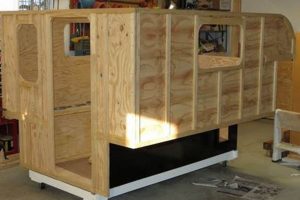A self-constructed apparatus designed to aid golfers in developing and maintaining an optimal swing path. These projects are often undertaken by individuals seeking a cost-effective solution for swing improvement, utilizing readily available materials to create a physical guide for their club movement. An example would be constructing a frame using PVC pipes to define the desired angle of ascent and descent during the swing.
The value lies in providing immediate visual and physical feedback, which can accelerate the learning process and ingrain proper muscle memory. Historically, golfers have employed various training aids to refine their technique. The rise of readily available information and materials has enabled more individuals to experiment with creating personalized solutions to address specific swing flaws. These projects foster a deeper understanding of swing mechanics and promote self-reliance in skill development.
The following sections will delve into the materials commonly used, construction techniques, and potential benefits of creating a custom swing plane aid. Furthermore, safety considerations and alternative training methods will also be discussed to provide a comprehensive overview.
Construction and Usage Recommendations
The subsequent recommendations aim to provide practical guidance for individuals embarking on the creation of a swing plane aid and its subsequent utilization.
Tip 1: Material Selection: Opt for durable and weather-resistant materials for the frame. PVC piping or metal conduit offers stability and longevity, particularly for outdoor use. Ensure all connecting joints are securely fastened to prevent structural failure during practice.
Tip 2: Angle Customization: Adjust the plane angle to align with the individual’s natural stance and swing characteristics. A steeper angle promotes an upright swing, while a flatter angle encourages a more around-the-body motion. Experimentation and video analysis are recommended to determine the optimal setting.
Tip 3: Controlled Movements: Initially, focus on slow, deliberate swings to acclimate to the defined plane. This allows for conscious awareness of clubhead positioning and minimizes the risk of developing compensatory movements.
Tip 4: Gradual Progression: As proficiency increases, gradually increase swing speed while maintaining adherence to the established plane. Consistent monitoring of ball flight and impact quality provides valuable feedback on performance.
Tip 5: Safety Precautions: Ensure sufficient clearance around the aid to prevent accidental contact during the swing. Exercise caution when practicing in confined spaces to avoid injury to oneself or damage to surrounding objects.
Tip 6: Regular Evaluation: Periodically reassess the alignment and stability of the constructed aid. Weathering and repeated use can compromise structural integrity, necessitating repairs or adjustments.
Tip 7: Complementary Drills: Integrate the aid with other swing drills to reinforce proper technique. For example, practicing takeaway or follow-through positions within the defined plane can enhance muscle memory.
Adhering to these recommendations will maximize the effectiveness of a homemade swing plane apparatus, contributing to improved swing mechanics and enhanced ball-striking consistency.
The subsequent sections will address troubleshooting common issues encountered during construction and provide insights into long-term maintenance strategies.
1. Materials
The selection of appropriate materials is paramount to the functionality and longevity of a self-constructed swing plane training aid. The chosen components directly impact the device’s stability, resistance to environmental factors, and overall effectiveness in guiding the golfer’s swing path.
- Structural Framework Materials
The primary structure of the aid often relies on materials such as PVC pipe, metal conduit, or wood. PVC offers lightweight and cost-effective construction, though its rigidity may be insufficient for aggressive swingers. Metal conduit provides greater strength and durability but requires specialized tools for cutting and joining. Wood offers a traditional aesthetic and can be shaped to specific angles, but it is susceptible to weathering and requires regular maintenance.
- Connecting Hardware
The integrity of the entire structure hinges on the quality of connecting hardware, including screws, bolts, and adhesive compounds. Galvanized or stainless steel fasteners resist corrosion and ensure long-term stability. PVC cement provides a permanent bond for PVC components, while wood screws offer adjustability for wooden structures. The chosen hardware must withstand repetitive stress and environmental exposure.
- Surface Coatings and Padding
Protective coatings, such as paint or sealant, extend the lifespan of the materials and enhance the aid’s aesthetic appeal. Padding, often made from foam or rubber, can be applied to contact points to prevent injury or damage to the golf club. The selection of coatings and padding should consider both durability and their potential impact on swing feel.
- Base Stabilization Materials
Ensuring a stable base is critical for accurate feedback. Materials such as sandbags, weights, or ground stakes may be necessary to prevent movement during use. The selection of base materials depends on the intended location of the aid and the level of stability required. Larger or heavier bases provide greater resistance to tipping or shifting.
The aforementioned facets demonstrate the multifaceted role of materials in a self-constructed swing plane training aid. Careful consideration of structural integrity, environmental resistance, and safety is crucial for creating an effective and durable device. Ultimately, the correct selection of materials contributes directly to the usability and long-term value of the swing training aid.
2. Angle
The angle incorporated into a self-constructed swing plane training aid is a foundational element dictating its effectiveness. The chosen angle directly influences the golfer’s swing path, affecting ball flight and overall consistency. A poorly configured angle can reinforce improper swing mechanics, leading to detrimental outcomes. For instance, an angle that is too steep may encourage an “over-the-top” motion, resulting in slices or pulls. Conversely, an angle that is excessively flat can promote an excessively inside-out swing, contributing to hooks or shanks. The accuracy and appropriateness of the set angle are, therefore, paramount.
Properly calibrating the angle necessitates an understanding of individual swing characteristics and desired outcomes. Golfers with naturally upright swings might benefit from a steeper plane angle, while those with flatter swings may find a shallower angle more conducive to their natural motion. Video analysis and professional guidance can aid in determining the optimal angle for a given golfer. The ability to adjust the angle on a homemade aid offers a significant advantage, allowing for fine-tuning based on feedback and swing development. A real-world application involves a golfer using an adjustable aid to gradually flatten their swing plane over time, correcting an over-the-top tendency and improving accuracy. Understanding the impact of angle and the capability to modify it are crucial for achieving improved swing mechanics.
In summary, the angle’s precision and appropriateness are non-negotiable aspects of a do-it-yourself swing plane aid. An inaccurately set angle can hinder progress, while a properly calibrated and adjustable angle facilitates targeted swing improvement. This underscores the need for careful consideration, expert consultation, and iterative adjustments during the construction and utilization of such a training device. The successful application of this understanding translates directly into enhanced swing mechanics and improved on-course performance.
3. Stability
Stability, in the context of self-constructed swing plane training aids, is a critical determinant of the device’s efficacy and safety. Any instability introduces variability and inaccuracies in the feedback provided, undermining the user’s ability to develop a consistent swing path. A stable platform is essential for reliable training.
- Base Rigidity and Weight Distribution
The base of the aid must possess sufficient rigidity to resist deformation during use. Inadequate rigidity results in inconsistent plane definition, hindering the development of proper muscle memory. Weight distribution should be balanced to prevent tipping, particularly during forceful swings. For example, a wide, weighted base constructed from sandbags or concrete blocks provides superior stability compared to a lightweight frame. This ensures consistent feedback, allowing the user to focus on swing mechanics without distraction.
- Material Strength and Joint Integrity
The chosen materials must exhibit adequate strength to withstand repeated stress. Weak materials or poorly constructed joints can compromise structural integrity, leading to wobble or collapse. Using high-quality PVC cement for PVC-based aids or securely fastened metal joints for metal-based aids is essential. A common failure point is the connection between the plane guide and the base, where repeated impacts can loosen fasteners. Regular inspection and maintenance are necessary to ensure continued stability.
- Ground Anchoring and Environmental Factors
For outdoor use, the aid must be securely anchored to the ground to mitigate the effects of wind and uneven terrain. Ground stakes or weighted bases are essential for preventing movement. Environmental factors, such as moisture and temperature fluctuations, can also affect stability. Wood-based aids are particularly susceptible to warping and rot if not properly treated. Protecting the aid from the elements can extend its lifespan and maintain its stability over time.
- Swing Force Absorption
The structure must effectively absorb the force generated during the golf swing. Excessive vibration or movement can disrupt the golfer’s concentration and introduce inaccuracies in feedback. Incorporating damping materials, such as rubber padding or vibration-absorbing mounts, can improve stability. For example, adding rubber feet to the base can reduce vibration and prevent slippage on hard surfaces. The effective absorption of swing force is crucial for consistent training sessions.
These facets underscore the importance of robust construction and careful attention to detail when building a self-constructed swing plane training aid. A stable and secure platform is paramount for delivering consistent feedback and promoting the development of a repeatable and effective golf swing. Compromising on stability undermines the entire purpose of the aid, rendering it ineffective and potentially dangerous.
4. Practice
Effective practice constitutes a fundamental component when utilizing a self-constructed swing plane training aid. The device, irrespective of its construction quality or the precision of its design, yields minimal benefit without dedicated and structured practice. The aid serves as a visual and physical guide, but it is the repetition of controlled swings within the defined plane that cultivates the desired muscle memory and swing mechanics. For instance, a golfer using a homemade swing plane aid might initially struggle to maintain the club within the designated parameters. However, consistent practice, focusing on slow, deliberate swings, gradually ingrains the correct swing path, leading to improved consistency and ball-striking ability.
The nature of practice is also crucial. Merely swinging the club repeatedly within the plane does not guarantee improvement. Focused practice, incorporating drills that emphasize specific aspects of the swing, maximizes the benefits. For example, a golfer might use the aid to practice the takeaway, ensuring the club is on the correct plane from the very beginning of the swing. Similarly, practicing the follow-through within the plane promotes a complete and balanced swing. Real-world observation reveals that golfers who combine the use of a swing plane aid with targeted practice drills demonstrate significantly faster and more sustained improvement compared to those who simply swing aimlessly.
In conclusion, the connection between dedicated practice and a self-constructed swing plane training aid is synergistic. The aid provides the framework and feedback, while focused practice provides the repetition and reinforcement necessary to translate that feedback into improved swing mechanics. Challenges arise when practice is inconsistent or lacks focus. The key takeaway is that the aid is a tool, and like any tool, its effectiveness is directly proportional to the skill and dedication of the user. Consistent, focused practice is the catalyst that unlocks the potential of the aid and drives tangible improvement in the golfer’s swing.
5. Safety
Safety is paramount when considering self-constructed swing plane training aids. The inherent risks associated with swinging a golf club, combined with the potential hazards of a home-built device, necessitate careful consideration. Improper construction or usage can lead to injuries to the golfer or bystanders. For instance, a poorly secured PVC frame could collapse during a swing, causing the golfer to lose balance or be struck by debris. Similarly, sharp edges or protruding fasteners on the device pose a risk of lacerations or puncture wounds. Therefore, mitigating potential hazards is crucial throughout the design, construction, and utilization phases.
The practical significance of safety extends beyond preventing immediate injuries. Recurring minor incidents, such as scrapes or bruises, can deter consistent practice, thereby hindering the intended benefits of the training aid. A safe and reliable device fosters confidence and encourages regular use, maximizing the potential for swing improvement. Moreover, a well-designed aid incorporates features that minimize the risk of common golf-related injuries, such as back strain or shoulder impingement. For example, ensuring adequate clearance around the device prevents overextension and promotes a more natural swing motion. A safety-conscious approach is, therefore, integral to the long-term effectiveness of the training aid.
In summary, integrating safety considerations into the creation and use of self-constructed swing plane training aids is not merely an optional precaution but a fundamental requirement. Neglecting safety can lead to injuries, deter practice, and ultimately undermine the intended benefits of the device. Prioritizing safe design, construction, and usage practices is essential for maximizing the value and minimizing the risks associated with these homemade aids. The challenge lies in balancing functionality with safety, ensuring that the training aid effectively promotes swing improvement without compromising the well-being of the user.
6. Maintenance
The longevity and consistent performance of a self-constructed swing plane training aid are directly contingent upon diligent maintenance practices. Absence of regular upkeep precipitates structural degradation, compromising the device’s ability to provide accurate feedback and potentially creating unsafe conditions. Material fatigue, environmental exposure, and repetitive stress contribute to component wear, necessitating proactive measures to mitigate these effects. For instance, PVC-based aids, commonly employed due to their cost-effectiveness, are susceptible to ultraviolet degradation, leading to brittleness and cracking. Routine application of a UV protectant mitigates this risk, extending the material’s lifespan. Similarly, metal components, particularly those exposed to moisture, are vulnerable to corrosion. Periodic cleaning and application of a rust inhibitor prevent structural weakening and ensure continued functionality.
The impact of neglected maintenance extends beyond material degradation. Loose joints, misaligned components, and compromised base stability introduce variability in the swing plane guidance, effectively negating the intended training benefits. A real-world example involves a golfer diligently practicing with an aid featuring a subtly misaligned support, unknowingly reinforcing an incorrect swing path. Regular inspection of all connections, fasteners, and structural elements is imperative. Tightening loose screws, replacing worn-out bolts, and reinforcing weak points prevent the gradual accumulation of errors that undermine the training process. Furthermore, environmental factors, such as prolonged exposure to sunlight or extreme temperatures, can distort or warp the materials, affecting the accuracy of the swing plane. Storing the aid in a sheltered environment when not in use minimizes these risks.
In summary, maintenance is not a supplementary task but an integral element of the “swing plane trainer diy” equation. Proactive upkeep safeguards the structural integrity of the aid, ensuring consistent and accurate feedback. Neglecting maintenance compromises the device’s functionality, potentially reinforcing improper swing mechanics and creating safety hazards. Regular inspection, cleaning, and preventative treatments are essential for maximizing the lifespan and effectiveness of a self-constructed swing plane training aid, ultimately contributing to sustained improvement in the golfer’s swing.
Frequently Asked Questions Regarding Self-Constructed Swing Plane Training Aids
The following addresses common inquiries and misconceptions surrounding the design, construction, and utilization of homemade swing plane training devices.
Question 1: Is a self-constructed swing plane aid as effective as a commercially manufactured one?
Effectiveness depends on design accuracy, construction quality, and diligent practice. A well-designed and constructed device can provide comparable feedback to commercial options, provided it adheres to proper swing plane principles.
Question 2: What materials are most suitable for building a durable and reliable aid?
PVC pipe, metal conduit, and treated lumber represent common choices. PVC provides affordability and ease of assembly, while metal offers greater structural integrity. Treated lumber provides an alternative, but demands consideration of potential environmental factors.
Question 3: How does one determine the correct swing plane angle for their individual swing?
Video analysis of the individual’s existing swing, coupled with guidance from a qualified golf instructor, provides the most accurate determination. Experimentation with adjustable angles is also recommended.
Question 4: What safety precautions should be observed when using a homemade swing plane aid?
Ensure ample clearance around the device to avoid accidental contact. Inspect the device regularly for structural integrity. Employ appropriate safety gear, such as eye protection, if necessary.
Question 5: How frequently should one practice with a swing plane aid to see tangible results?
Consistent, focused practice is essential. Short, regular sessions are more effective than infrequent, prolonged sessions. A minimum of three sessions per week is recommended.
Question 6: Can a self-constructed swing plane aid correct all swing flaws?
Aids are tools to support swing improvement. They cannot replace professional instruction or address underlying physical limitations. A comprehensive approach, combining the aid with expert guidance, yields optimal results.
In summation, while a homemade aid offers a cost-effective training option, its success hinges on careful design, proper construction, and consistent, safe practice. It is recommended to always consult with a professional golf instructor for guidance on personalized swing adjustments.
The subsequent section will explore potential modifications and customization options for self-constructed swing plane training aids.
Conclusion
The exploration of swing plane trainer diy reveals a spectrum of considerations, from material selection to safety protocols. Constructing a functional and reliable training aid necessitates a foundational understanding of swing mechanics and a commitment to precision in execution. The information presented underscores that successful implementation extends beyond mere construction; it demands consistent practice and diligent maintenance. This is not merely a project, but an investment in skill enhancement.
Ultimately, the decision to engage in swing plane trainer diy should be approached with a discerning eye. While the potential for cost savings is undeniable, the value derived from such an endeavor hinges on a commitment to quality and a sustained dedication to practice. Those who proceed with a clear understanding of the principles outlined herein are poised to realize the full benefits of this undertaking, fostering improvement and precision in their golfing technique. Further research and consultation with qualified professionals are encouraged to maximize the effectiveness and safety of any self-constructed training device.







